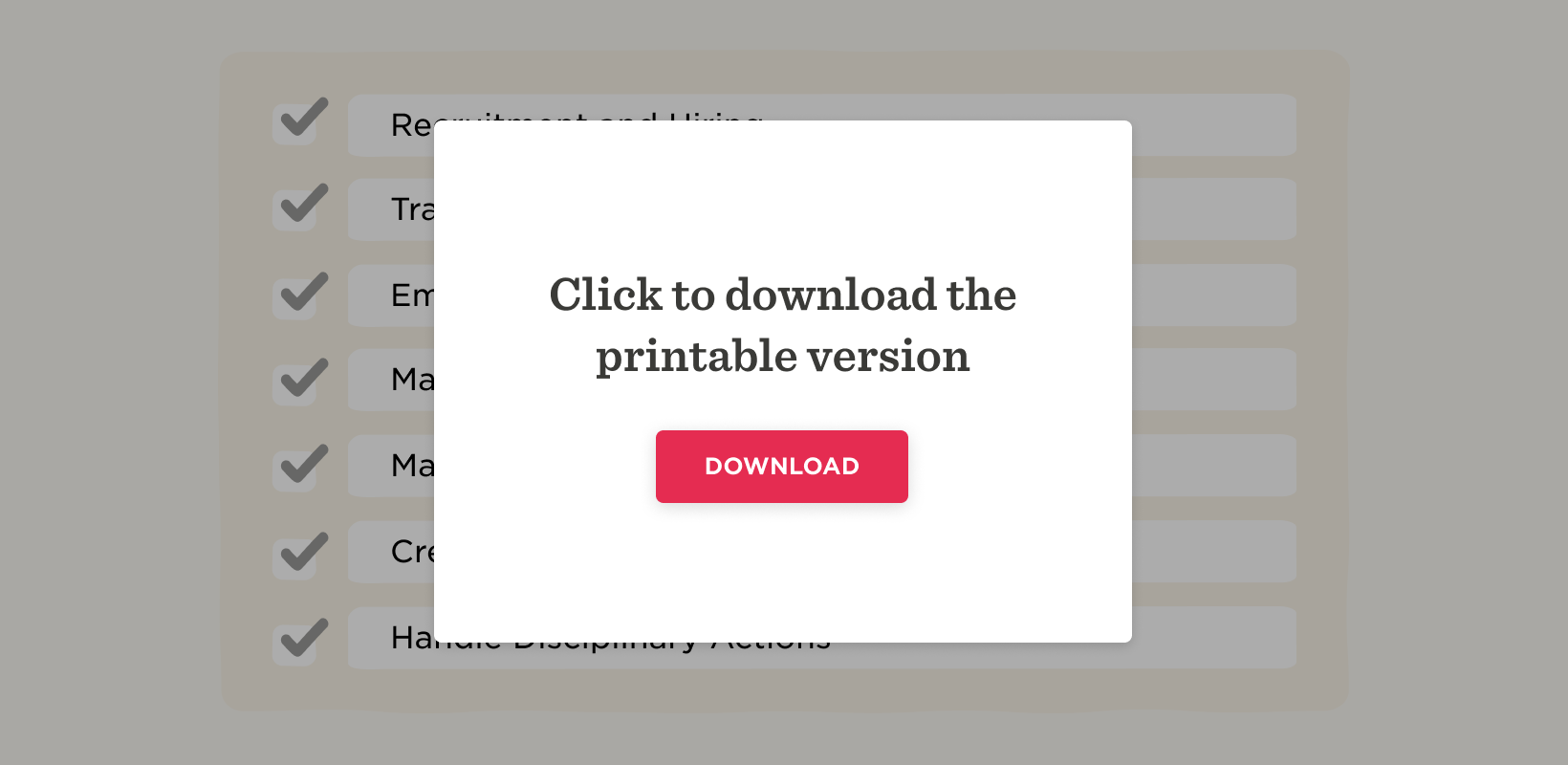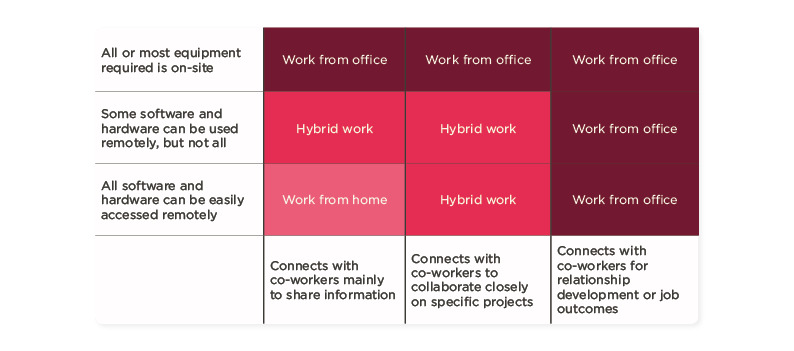During the course of the COVID-19 pandemic, hybrid work emerged as an effective means of maintaining both productivity and employee wellbeing. So it’s no surprise that many companies now see the need to create a full hybrid work policy—often for the first time.
Based on the results of our survey ‘The advantages of the hybrid work model’, we’ve created a checklist and employee survey template to help you construct your own hybrid work policy so that you can meet your company’s needs and look after your people’s wellbeing.
This HR checklist focuses on four key areas your policy may need to address:
- Jobs
- People
- Outcomes
- Policies
The first two steps in the checklist relate specifically to individual roles in your organization, and the final two steps relate to company-wide policies and procedures.
Plus, we’ve included a survey template you can adapt and use to effectively understand the needs and preferences of your people.

First things first
Before we get started, it might be helpful to decide which of these will apply to your hybrid work policy:
- Your policy will be universal across your organization, with fixed days in-office or remote
- Your policy will vary across your organization, with decisions made at the team level
- Your policy will be flexible across teams, with decisions made between a manager and employee
The more granular your policy is, the more work will be required to implement it. However, our survey suggests that granular policies decided at the team or employee level may be the most effective at empowering people and boosting productivity.
First up, we need to look at how your policy can address specific jobs and their suitability for remote and/or hybrid work. Let’s get started.
Step 1. Assess jobs for hybrid work
The first step in building a hybrid work policy is to determine which roles are suitable for a hybrid working model. Each role should be evaluated individually to decide how much, if any, flexibility exists for remote or hybrid work.
Our survey shows that offering employees some degree of choice about their work location and schedule provides a clear boost to productivity and employee wellbeing. So, this policy checklist assumes you’ll be undertaking a collaborative process with your teams, rather than creating a plan without their input.
Remember that if you implement company-wide policies—such as a commitment to a shift-work model—then that decision will impact your hybrid work policy too.
To accurately analyze the roles in your organization and make decisions that contribute to your hybrid work policy, it can be useful to look at their requirements for equipment and connections to people. Here’s a simple matrix that will help you to evaluate each role:

When you’re evaluating each role for its suitability for hybrid work, make your way through the following checklist items:
- Send anyone currently in the role your employee hybrid work survey (check out our template for inspiration). Their feedback will help you account for every aspect of their job.
- Determine how much use of on-site equipment the job requires. Add details such as specific software packages that cannot be accessed remotely and on-site hardware they need to operate.
- Evaluate the role’s normal interactions with co-workers and customers. These might typically fall into three categories:
- Some roles connect to other people primarily for sharing information.
- For example, a company’s bookkeeper, as most of their connection to others revolves around sending and receiving the correct information.
- Roles like these may be more suitable for remote and hybrid work.
- Other roles connect to people to collaborate on a shared project or outcome, but the outcome is not the relationship itself.
- For example, a software development team, because while they collaborate closely, the outcome is the software they develop.
- Roles like these may benefit from hybrid work that fosters connection but also allows independent work.
- There are roles where the connection with people is the outcome.
- For example, an account manager carrying out product demonstrations must ideally see their clients in person to be most effective.
- Roles like these are probably not suitable for hybrid work and may require a ‘work from office’ provision.
- Some roles connect to other people primarily for sharing information.
- Plot the outcome of your evaluation on the matrix above. This result should quickly show you how much flexibility there is for remote and hybrid work.
- Compare your results with the feedback you receive from employees and adjust your evaluation where appropriate.
Step 2. Support people through hybrid work arrangements
Providing hybrid working arrangements isn’t only about saving money or adjusting to the pandemic. It’s also about productivity and employee wellbeing.
For example, our survey revealed two key things about hybrid work:
- 66% of people with a work from home only model felt productive
- 68% of people with a work from office only model did NOT feel productive
When it comes to wellbeing, individual choice produces the best results. The only arrangements that we found to produce a positive impact on employee wellbeing were when they could either work remotely at will or in the split week model.
So it’s important to provide sufficient support as you implement a hybrid work policy. Here are some of the key checklist items to follow:
- Survey your employees to discover their needs and feelings about working from home (you can get started with our template below).
- Collate the results to look for company-wide trends that could inform your hybrid work policy.
- Consider ongoing surveys as a way to look after your employees’ wellbeing and help them achieve successful outcomes—so you can adjust your policy where necessary.
Step 3. Decide which outcomes you will measure in your hybrid work policy
So far, we’ve focused on how hybrid working can contribute to the success of your company and the wellbeing of your employees. But without properly measuring the impact of your new policy, you can’t be sure of protecting your people and maintaining productivity.
Here are the key steps to take:
- Decide how you will track employee performance when they are working from home. For example:
- Will they have a specific schedule to stick to?
- Will you use a virtual time clock for logging hours?
- Is overtime permitted automatically or allowed with manager permission?
- Will there be specific hours when employees must be online and can be scheduled for meetings?
- Monitor your key performance indicators (KPIs) specific to each role, such as calls handled, projects delivered, or sales closed, to be sure teams are meeting their established goals.
- Prepare a clear schedule for reviewing the data you track with the employee and the relevant managers.
- Consider regular surveys as a way of gauging the success of your policy, such as a quarterly employee wellbeing survey.
Step 4. Clarify your specific policies for hybrid work
Finally, it’s time to think about additional policies you may wish to include that are specific to your organization.
Your hybrid work policy may, for example, need to include employee benefits, technology access, and cybersecurity. A number of these policies are best formed in close collaboration with team members, and you’ll find specific questions in our employee survey template that will help you gather feedback relating to these areas.
Here are the main questions to work through to determine what to include in your hybrid work policy:
- Will the company provide video conferencing software and hardware?
- Will the company provide collaboration tools or communication software? If so, what are the expectations of employees’ availability on these tools?
- Will the company offer a stipend or reimbursement for equipment purchases for home offices?
- Will employees be required to use company-owned devices?
- Is there a company cybersecurity policy related to hybrid work?
- Are there extra benefits or compensation offered to hybrid workers?
- What is your time-tracking and overtime pay policy? Is it fit for hybrid work?
Ask the right questions, and your hybrid work policy will fall into place
Hybrid work policies will of course vary from one company to another. And the decision to implement either a company-wide or employee-specific policy will also make a major difference to its shape.
However, these four areas—jobs, people, outcomes, and policies—are likely to be present in most hybrid work policies. So it’s important to carefully think through each step to make sure your policy is truly fit for purpose.
If you’re planning your hybrid work policy based on collaboration, then an HR tool that promotes employee engagement is going to be a huge benefit. HiBob offers all the features you need to create a hybrid work policy, survey your employees, build individual onboarding workflows, and monitor employee feedback as you develop and implement your new policies.

Employee hybrid work preferences survey template
This brief survey template will help you gather feedback from your people, through a mixture of open-ended and closed questions.
In the first section of the survey, the questions focus on the role itself and their personal opinion. The answers can inform your hybrid work policy and highlight any specific needs or concerns your employees may be feeling.
In the second section, the questions focus on how employees can work remotely and whether they feel they have the tools to do so successfully.
—
Part 1: The suitability of your job for hybrid work
These first questions will help us understand how we might approach hybrid work for your role.
- We’d like to start by asking for your opinion about hybrid work for your role in general. How suitable is your role for remote or hybrid work?
- My job is not at all suitable for remote work.
- Remote work may be possible, but not very efficient for my role.
- Remote work would not change my efficiency.
- Hybrid work would increase my efficiency.
- My job should be done remotely.
- Please tell us about the equipment you use for your role. Are the software and hardware necessary for your job easily portable?
- All my equipment can be easily moved or replaced to work remotely.
- Some of my equipment can be accessed remotely, but office access is required for other tasks.
- Nearly all my work relies on equipment I can only access at the office.
- We’d like to understand how you work with others. What is the purpose of most of your connections to your co-workers?
- We mainly meet or message to transfer information.
- We work on shared projects and outcomes.
- Meeting others is the purpose of my job.
- Is there anything else you’d like us to consider as we develop our hybrid work policy?
- ___________________________________________________
Recommended For Further Reading
Part 2: Supporting you through hybrid work
We want to understand how you feel about hybrid work and how we can continue to help you develop as a person and in your career. Your answers to these questions will help us develop a people-centered hybrid work policy.
- In a general sense, how much are you in favor of remote and hybrid work?
- I hate the idea.
- I’m not sure yet—the devil is in the detail.
- I’m optimistic and looking forward to more clarity.
- I love the idea.
- Which of these hybrid arrangements is most appealing to you?
- WFH at will—you choose your work from home schedule.
- Split week—you or your team are in the office for a specific number of days each week.
- Shift work—each team works a shift decided by management.
- Week-by-week—you’ll work from home one week and from the office the next.
- No hybrid work whatsoever.
- Do you have all the digital tools (software, apps, access) you need for your work?
- Yes, I have access to everything I need.
- I have access to the core tools, but additional tools would be helpful.
- I do not have access to the digital tools necessary for my job.
- What additional digital tools would be helpful for you to do your job remotely?
- ________________________________________________
<<Print these checklists and survey questions to start your hybrid work policy.>>
Meet Bob
At HiBob, we’ve built a modern HR platform designed for modern business needs—today and beyond.
We focused on building something robust yet intuitive and easy to use, which has led Bob to be the platform of choice for thousands of fast-growing modern, mid-sized organizations.
For HR, it automates many common processes, allows greater oversight and visibility of the business, and centralizes all people data in a secure, user-friendly environment.
For managers, it provides access to data and insights to help them lead more effectively and streamline processes.
For employees, it’s the tools and information they need to connect, develop, and grow throughout their journey.
In a short time, Bob can be deployed to enable communication, collaboration, and connectivity that drives stronger engagement, productivity, and business outcomes.
